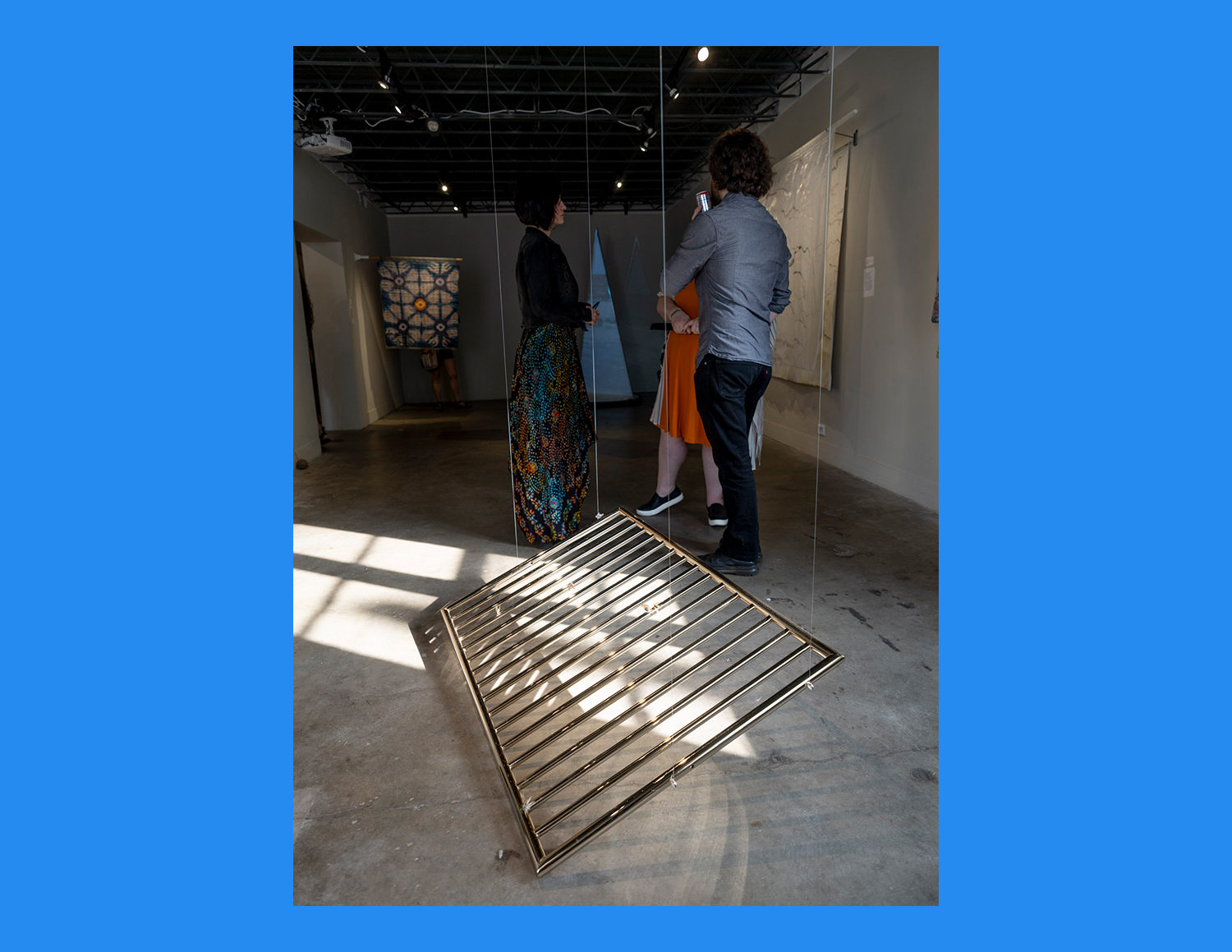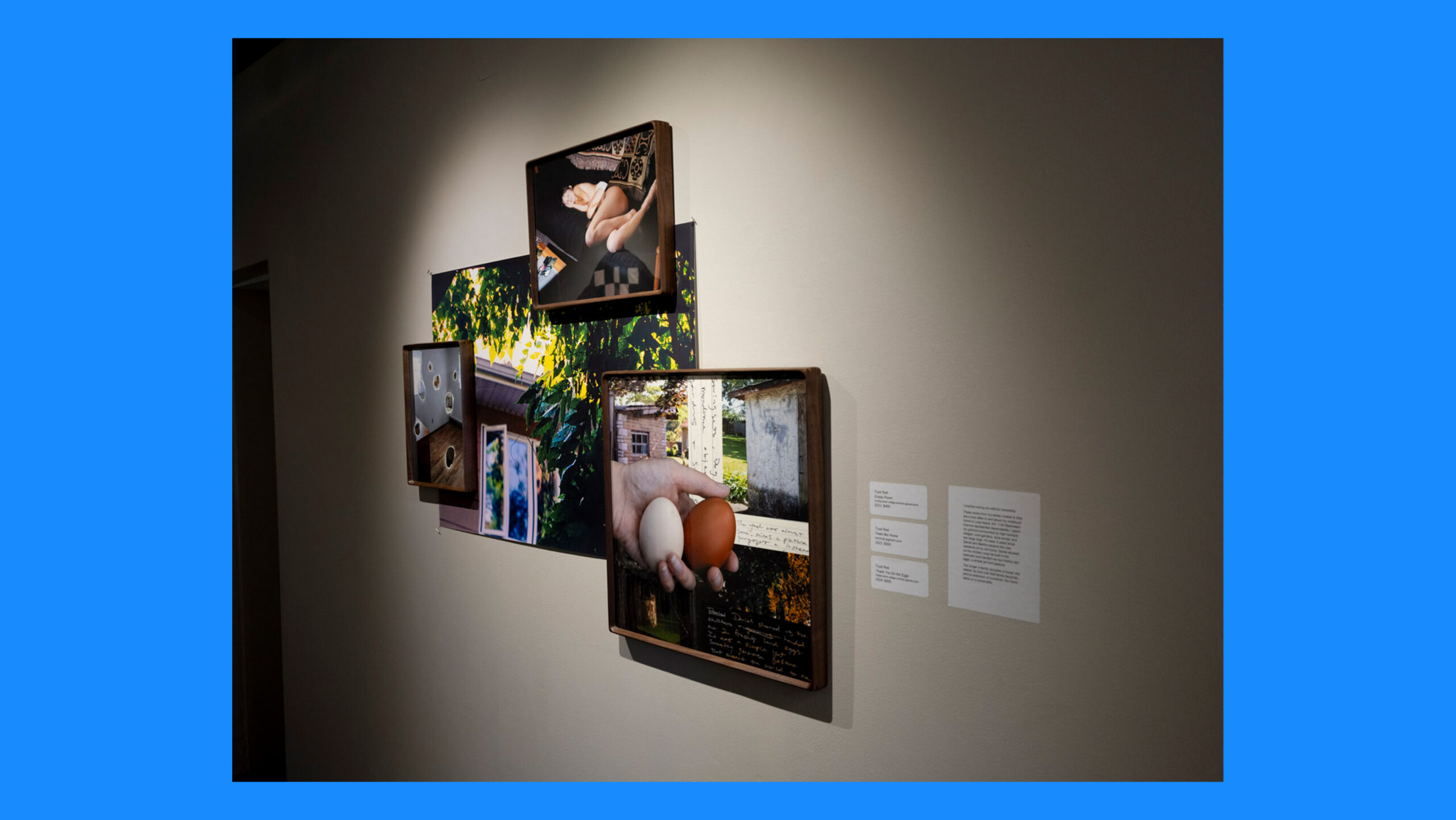
Jen Barker is a visual artist, educator, and curator from Houston, Texas. She holds a BFA in Sculpture from the University of Houston (2022) and an MFA in Sculpture from Cranbrook Academy of Art (2024). She was raised in a small, strict religious group called The Fellowship until the age of nineteen when she left. She was rebuked and ostracized by everyone she had known as family and friends. This formative, traumatic experience has informed her practice and life, as she rediscovers a sense of spirituality again—one that is apart from organized religion. Reconciling with her family and finding new connections has also greatly informed her practice and life. She has shown her work in venues such as Hatch Gallery, Annex Gallery, Flagstaff Strand Theatre Gallery, Grosse Point Artists Association, Forum Gallery, Pontiac Creative Arts Center, and Boyer-Campbell, along with other Fiber Club members. She lives in Roseville with her spouse and three cats.
DC: How did the initial stages of curating Finding Our Way Home come together? What led you to choosing these concept of “home” and “displacement” as a thematic framework for the exhibition, and how did you go about choosing the artists and works presented in the show?
For this show, the thematic concept came first, and the opportunity and space came second. I had just graduated with my MFA and had been dealing with loneliness and displacement myself. I moved across the country for grad school, and my spouse and I had long since decided we were not going back to Texas. But intention does not prevent feeling out of place. We had to start over, building a friend group and support network. Art grad school also has a way of undoing you and leaving you to pick up the pieces and put yourself back together again. So, in the process of recentering myself and figuring out what ultimately mattered to me and my art practice, I kept thinking about home. I could not stop thinking about home and how it is not just a physical place, but a social connectedness, and an emotional and spiritual feeling of security. I was thinking about how it often requires a kind of loss or trauma to find and appreciate what home really means. And so, I think any kind of displacement is like the opposite of home, and creates this desperate urge to recreate some sort of home from the broken pieces.
As for choosing the artists and works, from the moment I found a space to curate the show, I had a few names already in my mind: Yasmeen Nematt Alla, Taylor Knight-Turner, Kelly Tapia-Chuning, A Ranic, and a few others. Kelly and A were not able to participate, but Yasmeen and Taylor were. From there, I connected with Fiber Club and asked around to find other artists whose work fit the theme. Rita Patel was one of the first artists from Fiber Club to reach out to me. When she described her large work made during a residency in Ireland, I knew this piece would be the focal point of the show. traces…felt, left… was poetic and gentle. It was shimmering and interactive as viewers walked past and watched the organza move in response. And it contained the exciting moment of standing on the side and peeking behind the sheer front piece, observing all the interactions between the marks on the two layers. Rita suggested Natalia Petkov to me, who described her family history of escaping the Holocaust and rebuilding in the States. She was exploring this family history and generational trauma through photography, removing the faces and identities from old family photos. In this series, I saw layers of separation and violent removal. I saw what I described prior about displacement being the other side of the coin that brings a desire for home. In the emptiness where the faces were, I saw the ability for viewers to insert themselves and relate. Kira Keck and Kit Parks followed, sharing very different approaches to the topic: Kira with their large weavings that reference a kind of queer nostalgia, trying to find belonging in childhood homes, and Kit with their delicate and serious dyed and sewn works. The last artist to join the show was Tryst Red, a friend and colleague. I was, of course, familiar with her works, but I had not seen her newer series centering on home. When she showed me this newer work, I was excited to include a few pieces from the series Unable to Stay. A little later, another artist who was going to participate had to back out, leaving an empty space to fill. Instead of choosing an existing work, I decided to give Tryst free rein to create a new installation. I love the idea of trusting artists with the space to experiment and create without bounds. She pulled a new creation from another show and exhibited it in a new way in Portal, Take Me Back.

DC: In the curatorial statement for the show you discuss how the titular concept of “finding our way home” holds meaning that can be personal, but also social and political. What were a few different examples of works within the show that speak to how “home” can be a valence for these different realms of social, political, and personal?
Thinking about the pursuit of home theoretically, it is easy to see how the topic can be personal, social, and political, especially in today’s climate. In my own practice, I have long made highly personal artworks and argued that the personal is also universal. What I meant by that was an acknowledgement that few can relate to my upbringing in a religious cult and ostracization from the only friends and family I had ever known. But many can relate to the feelings that lie beneath my experience: disappointing your caregivers, being let down by those who were supposed to love you unconditionally, losing relationships you thought were important and meant to last; feelings of hurt and longing for justice; feeling alone and slowly choosing a new family based on bonds rather than blood; and struggling to redefine right and wrong for yourself, opposing what you were raised to believe.
It is also easy to see home as a social concept; something that carries different connotations depending on culture and generation, and social circle. And this has especially become more and more political as those seeking new homes are hunted, criminalized, dehumanized, imprisoned, and deported.
A work from the show that comes to mind on this topic is Irvine, CA by Taylor Knight-Turner. This small bronze work relates questions of personal home to the land and animals that share that land. In her statement, she wrote about the alienation of suburbia and its infiltration into the rural and natural worlds. I also see how the natural world continues to sustain suburbia, however disconnected they may be from each other. I see how, in this capitalistic, colonial hellscape we have created, we still rely on and put the weight of our survival on the land and animals. But, as Taylor’s practice continually speaks to, only respectful, reciprocal engagement with the land and animals will be sustainable in any kind of long-term. So this work speaks to Taylor’s personal experience of alienation, but also to the social behaviors of American suburbs and the political realities of unsustainable living.
Another work that comes to mind is Kit Park’s piece, Open Air. This work is inherently social and political; the two are inseparable. Inserted into the fabric of this two-sided flag fraught with Americana are symbols and references to Armenian carpets. This juxtaposition and insertion references both their personal family history and, again, a universal experience of dual identity. It also speaks to the politics of escaping genocide and finding a new home in a place that is also engaged in a genocide of its Indigenous population. Layering all of this meaning into a flag becomes a confessional piece that waves in the wind with both pride and pain.
DC: In an American context, we are living in a moment in which both federal funding for museums and grants for the arts are being determined by the art’s ability to express supposed “American values.” As an artist and curator how do you speak to this current moment?
The unfortunate reality is that artists and curators often end up producing work without any kind of compensation. There is the promise of “exposure” and connections, but that does not equal actual money to pay the bills. This is especially true when creating work that is openly critical of “American values.” This American capitalist society does not value art unless it produces a profit for the corporations and is consistently removing what little funding previously existed. I know some artists and curators who manage to support themselves through a mix of residencies, teaching, independent grants, and selling their work. But I also know many who can barely make ends meet and rely on a “day job” and/or a partner’s income. I have not found a perfect solution to this problem. I just know that I cannot sacrifice my values for the sake of making art more palatable to the wealthy. I truly wish there were more funding and opportunities for artists and curators to sustain themselves. I think there is an error in public thought that creating and curating art is not labor worthy of compensation. But creatives know that not only does it take labor to create art, but that labor is necessary to the survival of our culture and humanity.

DC: We have a “thesis question” here at Detroit Cultural that we ask every interviewee: “what are the social and political responsibilities of your particular job in the field of art/cultural production?” As both the curator, and an exhibiting artist in this exhibition, I would love to hear your answer in relation to both positions and their possible responsibilities?
I have long thought that my favorite art was a mixture between that which renewed my awe for the world, and that which made me think more critically. That awe could be seeing something beautiful, but it could also be something that made me experience wonder, like poetry that more fully expresses a human emotion, or music you can feel in your soul. I consider it my hope to create and curate art that accomplishes one or both of these goals. But responsibility is different. There have been times I have created painfully personal artworks and been told I should have included a trigger warning. So I consider that to be one of my responsibilities now, to either ensure the content is not too much for a vulnerable person to handle, or to provide a chance for viewers to opt out of the experience.
I also think that, as a cultural producer through both roles, that I have a responsibility to acknowledge and make space for discussion of current events. I do not want to make or curate work that lives in an escapist La-La land, completely disconnected from our reality. It may not always be my place to speak directly about everything that is happening. But, as an artist, I feel it is my role to create art that makes viewers feel human again and reminds them that they are not alone. As a curator, I feel it is my responsibility to gather artists and give them the freedom to exist and create work that speaks in ways that need to be spoken. By this, I mean both giving opportunities for marginalized folks to speak for themselves and be fully human, but also allowing them to imagine new worlds. I cannot speak to all the issues I care about myself because they are not always mine to speak to. But collectively, we can dream of a better place where we are all at home.




